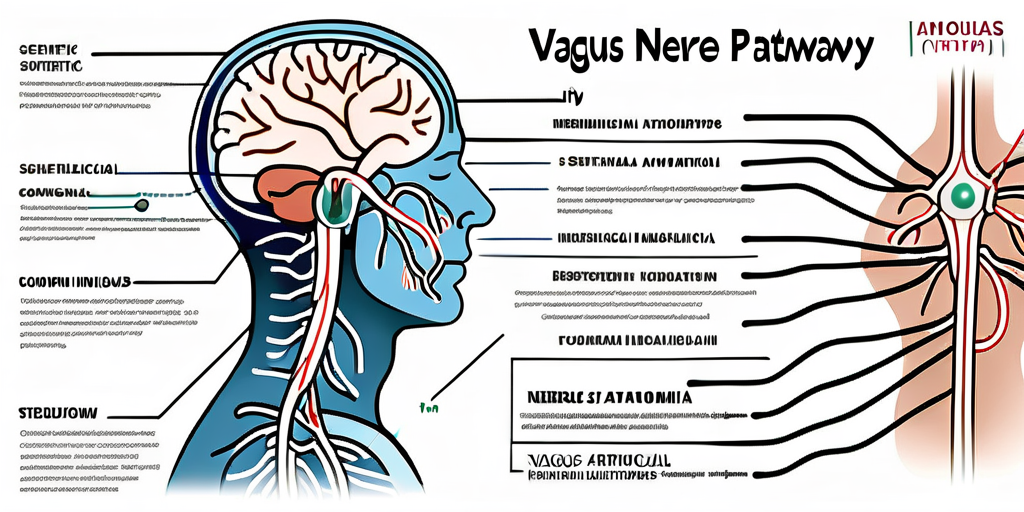vagus nerve meditation script
The vagus nerve is a fascinating and powerful component of our nervous system, playing a vital role in our overall well-being. In recent years, the connection between the vagus nerve and meditation has gained increasing attention. Through dedicated practice, individuals have discovered that activating and stimulating the vagus nerve during meditation can have profound effects on their mental and physical health.
Understanding the Vagus Nerve
The vagus nerve, also known as the tenth cranial nerve, is the longest and most complex nerve in the human body. It originates in the brainstem and extends through the neck and chest to the abdomen. It is a key communication pathway between the brain and various organs, including the heart, lungs, and digestive system.

The vagus nerve consists of both sensory and motor fibers, enabling it to transmit messages from the body to the brain and vice versa. It plays a crucial role in regulating many bodily functions, such as heart rate, digestion, and inflammation.
The Role of the Vagus Nerve in the Body
The vagus nerve is responsible for the parasympathetic nervous system, often referred to as the rest and digest system. When activated, it helps promote relaxation and prompts the body to enter a state of calm and rest. On the other hand, when the sympathetic nervous system, also known as the fight or flight response, is dominant, it can lead to stress and anxiety.
By engaging the vagus nerve, we can counterbalance the effects of stress and activate the body’s natural relaxation response. This restoration process is crucial for maintaining our mental and physical well-being.
The Connection Between the Vagus Nerve and Meditation
Meditation is a practice that involves focusing one’s attention and eliminating the stream of thoughts that often occupies the mind. Through consistent and intentional meditation, individuals can experience various benefits, including reduced stress levels and improved overall health.
Research has shown that specific meditation techniques, when coupled with vagus nerve stimulation, can enhance the overall effectiveness of the practice. By targeting and activating the vagus nerve during meditation, individuals may experience a deeper sense of tranquility and heightened states of relaxation.
Furthermore, studies have indicated that regular meditation can lead to long-term changes in the structure and function of the brain. Specifically, it has been found that meditation can increase the thickness of the prefrontal cortex, which is responsible for executive functions such as decision-making and emotional regulation. This suggests that meditation not only has immediate benefits for relaxation but also has the potential to improve cognitive abilities and emotional well-being over time.
In addition to its impact on the brain, meditation has also been found to have positive effects on the body. It has been shown to reduce blood pressure, improve immune function, and even slow down the aging process at a cellular level. These findings further highlight the potential of meditation as a powerful tool for overall health and well-being.
The Science Behind Vagus Nerve Stimulation
Vagus nerve stimulation, or VNS, refers to the process of intentionally activating the vagus nerve to promote relaxation and well-being. While the exact mechanisms behind vagus nerve stimulation are still being explored, research has uncovered several fascinating effects of this practice.
The Effects of Vagus Nerve Stimulation on the Brain
Vagus nerve stimulation has been shown to have a direct impact on brain activity. Studies have revealed that stimulation of the vagus nerve can modulate the release of neurotransmitters, such as serotonin and norepinephrine, which are important for mood regulation and overall mental health.
Furthermore, VNS has also been found to enhance neuroplasticity, the brain’s ability to reorganize and form new neural connections. This can contribute to improved cognitive function and emotional well-being.
Interestingly, recent research has shown that vagus nerve stimulation can also influence the production of brain-derived neurotrophic factor (BDNF), a protein that plays a crucial role in promoting the growth and survival of neurons. Higher levels of BDNF have been associated with improved memory, learning, and overall brain health.
Health Benefits of Vagus Nerve Stimulation
Engaging the vagus nerve through meditation and stimulation has been associated with numerous health benefits. Research suggests that regular vagus nerve stimulation can help reduce symptoms of anxiety and depression, improve heart health, enhance digestion, and even alleviate chronic pain.
Additionally, consistent VNS has been shown to have anti-inflammatory effects, which may be beneficial for individuals with conditions such as autoimmune disorders and chronic inflammation.
Moreover, recent studies have also indicated that vagus nerve stimulation can have a positive impact on the immune system. Activation of the vagus nerve has been found to regulate the production of pro-inflammatory cytokines, molecules that play a key role in immune response. By modulating the immune system, VNS may help promote a balanced immune response and reduce the risk of chronic inflammatory diseases.
Overall, the science behind vagus nerve stimulation is a rapidly evolving field, with researchers uncovering new insights into the profound effects this practice can have on the brain and overall health. As our understanding deepens, the potential applications of vagus nerve stimulation continue to expand, offering promising avenues for improving well-being and quality of life.
Preparing for Vagus Nerve Meditation
Before beginning your vagus nerve meditation, it’s essential to create a calm and distraction-free environment. This will allow you to fully immerse yourself in the practice and optimize the stimulation of your vagus nerve.

Creating a Calm Environment
Find a quiet space where you can meditate without interruptions. Consider dimming the lights or using soft lighting to create a soothing atmosphere. It may also be helpful to remove any clutter or distractions from the room.
Imagine transforming your meditation space into a sanctuary of tranquility. Soft, ambient music playing in the background can further enhance the peaceful ambiance. You may want to incorporate elements of nature, such as fresh flowers or a small indoor fountain, to bring a sense of harmony and serenity to the space.
Proper Posture and Breathing Techniques
Adopting a comfortable yet stable posture is crucial for maintaining focus during meditation. Sit on a cushion or chair with your back straight, aligning your head, neck, and spine. Gently close your eyes and take a few deep breaths to prepare your body and mind for the meditation ahead.
As you settle into your posture, let your awareness shift to your breath. Notice the gentle rise and fall of your abdomen with each inhalation and exhalation. Allow your breath to flow naturally, without forcing or controlling it. This mindful attention to your breath will help anchor you in the present moment, allowing you to fully engage in the vagus nerve meditation.
Now, take a moment to appreciate the power of your breath. Each inhale brings in fresh oxygen, nourishing your cells and invigorating your body. With each exhale, you release tension and stress, allowing your body and mind to relax and unwind. Embrace the rhythm of your breath as it becomes a guiding force throughout your meditation practice.
A Step-by-Step Guide to Vagus Nerve Meditation Script
Now that you have set the stage for your meditation practice, let’s dive into the step-by-step process of activating and stimulating your vagus nerve through meditation.
Beginning the Meditation
Start by bringing your attention to your breath. Take a moment to notice the natural rhythm of your breath, without trying to modify it. Feel the gentle rise and fall of your abdomen or chest as you inhale and exhale.
As thoughts or distractions arise, gently acknowledge them without judgment, and let them go. Direct your focus back to your breath, allowing yourself to fully immerse in the present moment.
By focusing on your breath, you create a sense of grounding and stability within yourself. This foundation allows you to explore the depths of your inner world and connect with the subtle energies that flow through your body.
Visualizing and Activating the Vagus Nerve
With your breath as your anchor, shift your attention to your vagus nerve. Visualize it as a delicate, soothing blue light running through the core of your body, connecting your brain, heart, and gut.
Imagine this blue light expanding and growing brighter with each breath. As you inhale, imagine the light filling your body, nourishing your vagus nerve and enveloping you in a profound sense of calm and relaxation.
As the blue light flows through your body, it gently massages and stimulates your vagus nerve, releasing any tension or blockages that may be present. With each breath, you can feel the healing energy of the light spreading throughout your entire being.
Exploring the Depths of Inner Stillness
As you continue to visualize and activate your vagus nerve, allow yourself to explore the depths of inner stillness. Notice any sensations or subtle shifts in your body and mind. Embrace the silence and tranquility that resides within you.
Within this state of deep stillness, you may find a profound sense of connection to yourself and the world around you. It is in this space that you can tap into your intuition, creativity, and inner wisdom.
Take your time to fully immerse yourself in this experience. Allow the gentle waves of relaxation and peace to wash over you, rejuvenating your mind, body, and spirit.
Concluding the Meditation
After spending some time with the visualization and activation of your vagus nerve, gently transition back to your breath. Allow yourself to sit in stillness for a few more moments, observing any sensations or emotions that arise.
When you’re ready, slowly open your eyes and take a few moments to reflect on your experience. Notice how your body feels and any subtle changes in your mental and emotional state. Embrace this renewed sense of calm and well-being as you continue with your day.
Remember, the practice of vagus nerve meditation is a journey of self-discovery and self-care. Each time you engage in this practice, you deepen your connection to your inner world and cultivate a greater sense of balance and harmony in your life.
Tips for Enhancing Vagus Nerve Stimulation During Meditation
To maximize the benefits of vagus nerve stimulation during meditation, consider incorporating the following tips into your practice:

Incorporating Mindfulness Practices
Mindfulness practices, such as body scans or loving-kindness meditation, can deepen your connection to the present moment and enhance the effects of vagus nerve activation. Experiment with different techniques to find what resonates most with you.
When it comes to incorporating mindfulness practices into your meditation routine, it’s important to remember that there is no one-size-fits-all approach. Each individual is unique, and what works for one person may not work for another. Therefore, it’s crucial to explore different techniques and find the ones that align with your personal preferences and needs.
For example, if you find that body scans help you cultivate a deeper sense of awareness and relaxation, you can incorporate them into your meditation practice. During a body scan, you systematically bring your attention to different parts of your body, noticing any sensations or areas of tension. This practice not only helps you connect with your physical body but also promotes a sense of grounding and presence.
On the other hand, if loving-kindness meditation resonates with you, you can explore this practice to enhance the effects of vagus nerve stimulation. Loving-kindness meditation involves cultivating feelings of love, compassion, and kindness towards yourself and others. By directing positive intentions towards yourself and others, you not only activate the vagus nerve but also foster a sense of interconnectedness and well-being.
Regular Practice and Patience
Consistency is key when it comes to vagus nerve meditation. Set aside dedicated time each day to nurture your practice. Remember, it may take time to notice the full benefits, so be patient with yourself and allow the process to unfold naturally.
Developing a regular meditation practice requires commitment and discipline. It’s important to create a routine that works for you and stick to it. Whether you choose to meditate in the morning, during your lunch break, or before bed, find a time that feels manageable and realistic for you.
Additionally, it’s essential to approach your meditation practice with patience and an open mind. The effects of vagus nerve stimulation may not be immediately noticeable, and that’s okay. Just like any other skill or habit, it takes time and consistent effort to develop and reap the full benefits. Trust in the process and allow yourself to grow and evolve along the way.
Potential Challenges and Solutions in Vagus Nerve Meditation
While vagus nerve meditation can be incredibly rewarding, it’s essential to acknowledge and address potential challenges that may arise along the way. By understanding and finding solutions to these challenges, you can enhance your meditation practice and reap the full benefits of vagus nerve stimulation.
Dealing with Distractions
During meditation, distractions may occur, pulling your focus away from the vagus nerve stimulation. It could be the sound of a passing car, a sudden itch on your nose, or even a wandering thought. When this happens, it’s important not to get discouraged. Instead, gently redirect your attention back to your breath and the visualization of your vagus nerve. Use these distractions as an opportunity to practice letting go and refocusing. Remember, the more you practice, the better you become at maintaining your focus.
One helpful technique to deal with distractions is to imagine them as passing clouds in the sky. Just as clouds come and go, so do distractions during meditation. Acknowledge their presence, but don’t let them linger. Allow them to drift away, returning your attention to the soothing rhythm of your breath and the gentle stimulation of your vagus nerve.
Overcoming Initial Discomfort
As with any new practice, you may experience initial discomfort or difficulty in fully engaging with vagus nerve meditation. This discomfort could manifest as physical tension, restlessness, or even resistance to the practice itself. It’s important to remember that this is completely normal and part of the learning process.
One way to overcome initial discomfort is to explore different techniques. Vagus nerve meditation can be approached in various ways, such as through deep breathing exercises, guided visualizations, or even incorporating gentle movements like yoga or tai chi. Experiment with different methods and find what resonates with you the most. Remember, there is no one-size-fits-all approach to meditation, so be open to adjustments and find what works best for your unique needs.
Additionally, it’s crucial to trust the process. Rome wasn’t built in a day, and the same goes for your meditation practice. Over time, with consistent effort and patience, the practice will become more comfortable and natural. Just like any skill, it takes time to develop and refine. Embrace the journey and celebrate the small victories along the way.
The Long-Term Impact of Vagus Nerve Meditation
Committing to vagus nerve meditation can yield long-lasting positive effects on both your mental and physical health, enhancing your overall well-being.
Mental Health Improvements
Regular vagus nerve stimulation through meditation has shown promising results in reducing symptoms of anxiety, depression, and stress. It can help cultivate a more balanced emotional state and promote resilience in the face of life’s challenges.
Physical Health Enhancements
Vagus nerve stimulation has also been linked to improvements in various physical health aspects. It can support cardiovascular health, digestive function, and immune system regulation. By fostering relaxation and reducing inflammation, vagus nerve meditation can contribute to an overall healthier and more vibrant lifestyle.
In conclusion, vagus nerve meditation is a powerful practice that can be incorporated into your daily routine to promote relaxation, resilience, and optimal well-being. By understanding the role of the vagus nerve and following the step-by-step meditation script, you can activate and stimulate this incredible nerve, experiencing profound mental and physical benefits. Remember, consistency and patience are key as you embark on this transformative journey. Embrace the present moment and allow the healing power of your vagus nerve to guide you on a path of true wellness.






